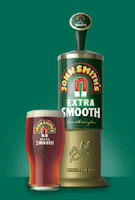“What’s the matter, lagerboy?” goes the Hobgoblin advert, “Afraid you might taste something?” Well, actually he probably is, possibly something along the lines of vinegar or yeast.
It has long been an article of faith amongst many in CAMRA that people only drink keg beers and lagers because they have been taken in by advertising and promotion into believing that these products are desirable, and they need to be educated into seeing the light and switching to the proper stuff. But surely that view is very disrespectful of the judgment of most beer drinkers, and if you’re trying to change someone’s mind you’re off to a bad start if you call them stupid.
Most people who drink beer are not really particularly interested in the subject, and tend to drink the same brew or a limited range rather than constantly experimenting. To them, it makes sense to choose something familiar and consistent from what they perceive as a reputable source. They want it to be refreshing, to lubricate their socialising with friends and to have something of an alcoholic effect on them, and if it meets those needs reliably then they’re happy to buy it. They may well see it as desirable to avoid extremes of flavour that would have the beer buffs’ tastebuds tingling.
It has been said that all the advertising in the world will only sell a bad product once, and if people are repeat purchasers of kegs and lagers then obviously they must satisfy their requirements – which will not be the same as the requirements of a beer enthusiast.
For example, I have no interest whatsoever in breakfast cereals. There are hundreds of different varieties on the market, but I eat the same one pretty much every day of the year. With the same type of milk and the same type of sugar on it. But I don’t think that makes me a fool.
There are some people who give the impression of trying to live their entire lives on the bleeding edge of experiment and unconventionality. And they are often some of the most crashing, self-obsessed bores you can hope to meet. Life really is too short for that kind of approach – you have to decide what matters to you and take the rest as it comes.
It also cannot be denied that there is a strong and genuine demand for beers served colder than the natural cellar temperature that is appropriate for cask. If people really didn’t want cold beer, they wouldn’t buy it. They only didn’t buy it in the past because the refrigeration facilities weren’t available. And of course far too much cask beer still ends up being served well above cellar coolness anyway.
I have written before about the “quality lottery” involved in drinking cask beer. For some people, the peaks are well worth enduring the occasional troughs, and they take the view they end up better off all round. But for others, indeed the majority, keeping their stake in their hand and keeping out of the troughs seems a better bet.
It is maybe less true now, but in the past many car enthusiasts would praise the driving qualities of Alfa Romeos. The only problem was, they were likely to leave you stranded by the roadside rather too often, so it wasn’t surprising people chose to buy Toyotas instead which at least could be relied upon to get them from A to B, even if in a somewhat dull and predictable manner.
For most drinkers, beer is just a commodity, and within their terms of reference they are making a rational and sensible choice by picking well-known keg and lager brands. In no way are they deluded dupes. That is what suits them according to their criteria.
Surely in this era of pub closures and anti-drink hysteria it’s a good thing that people are drinking beer at all. And if you want to encourage them to take more of an interest in the subject rather than just accepting the default choice, the way to do it is to communicate your own enthusiasm rather than telling them they’re stupid.
























